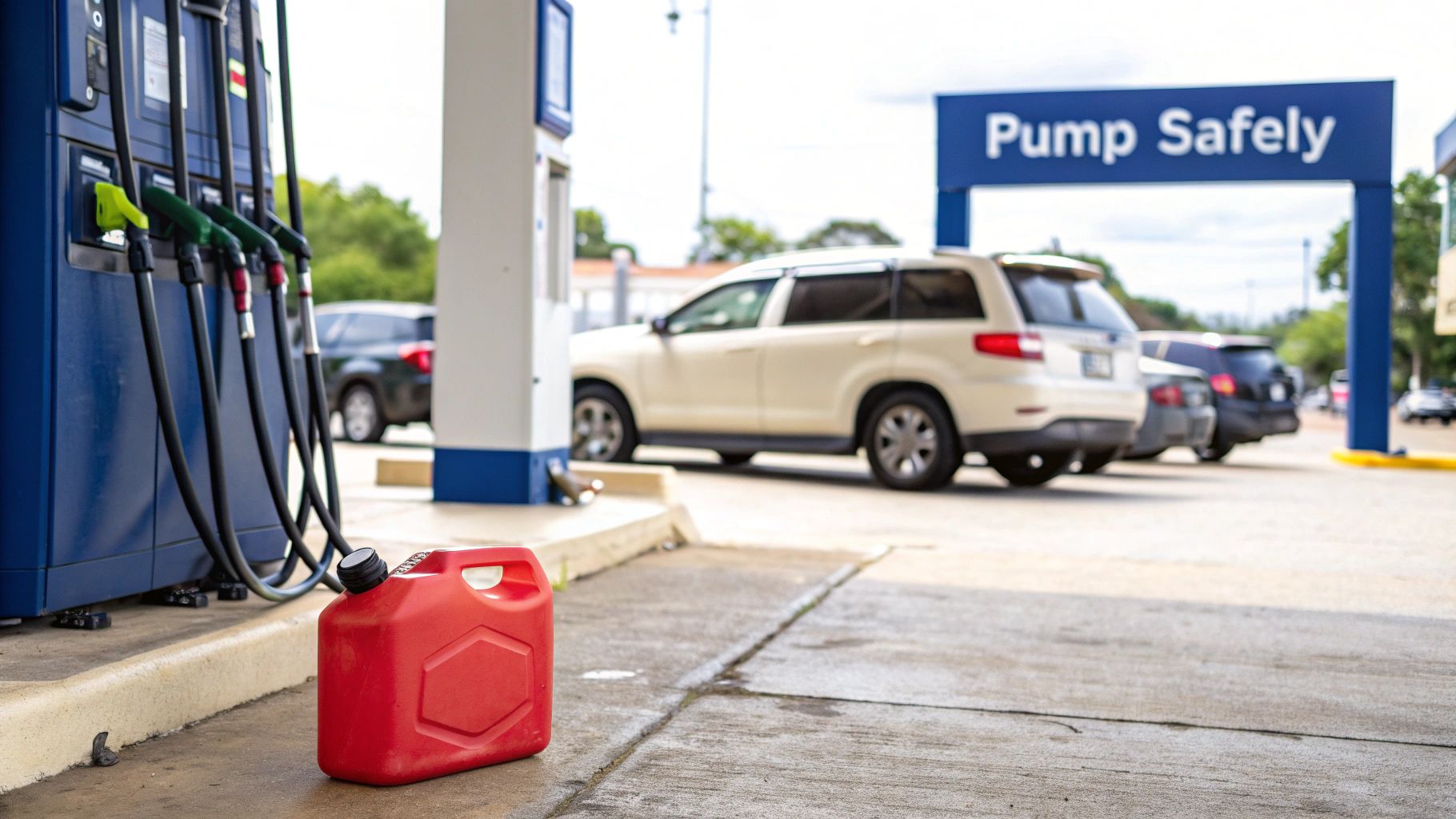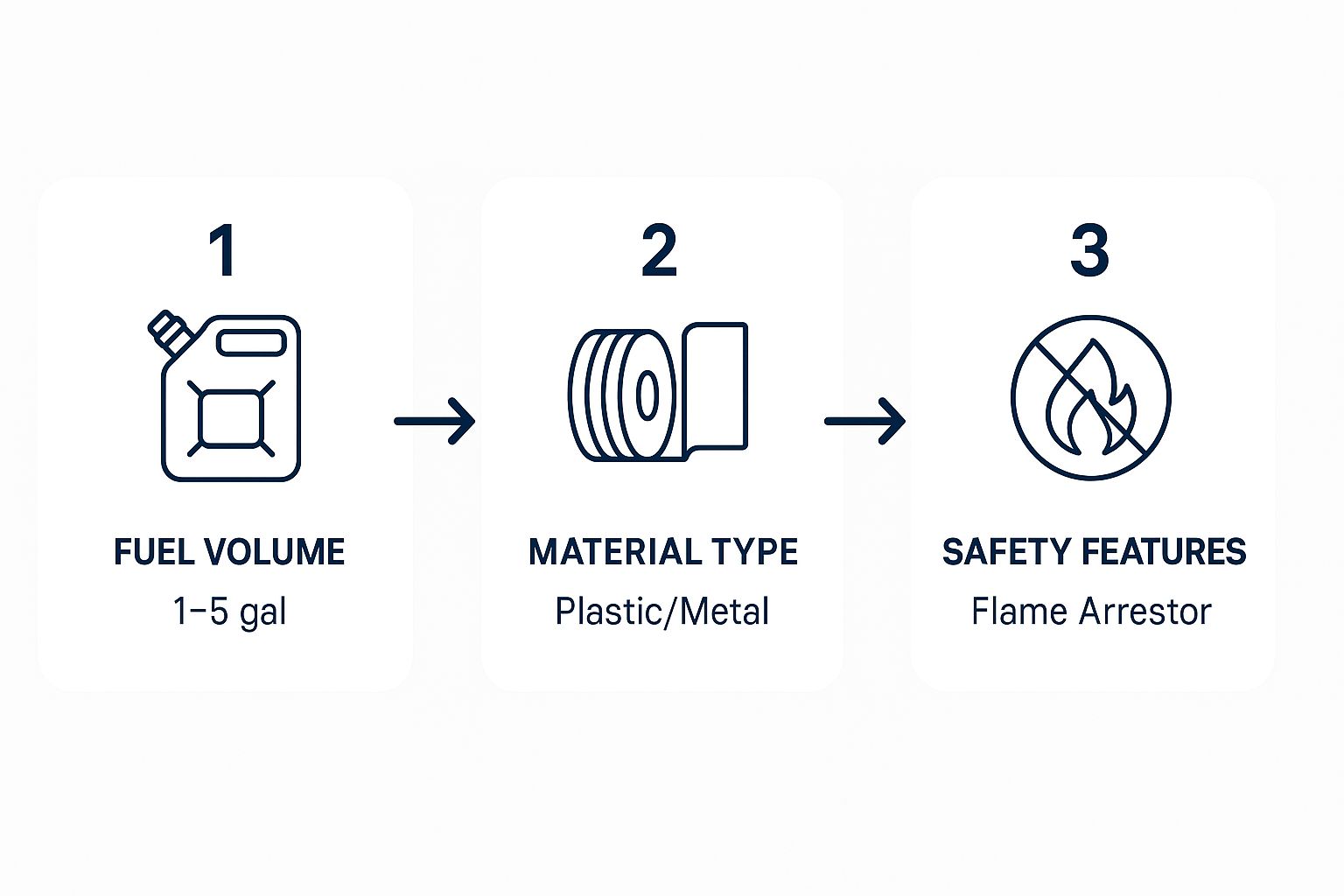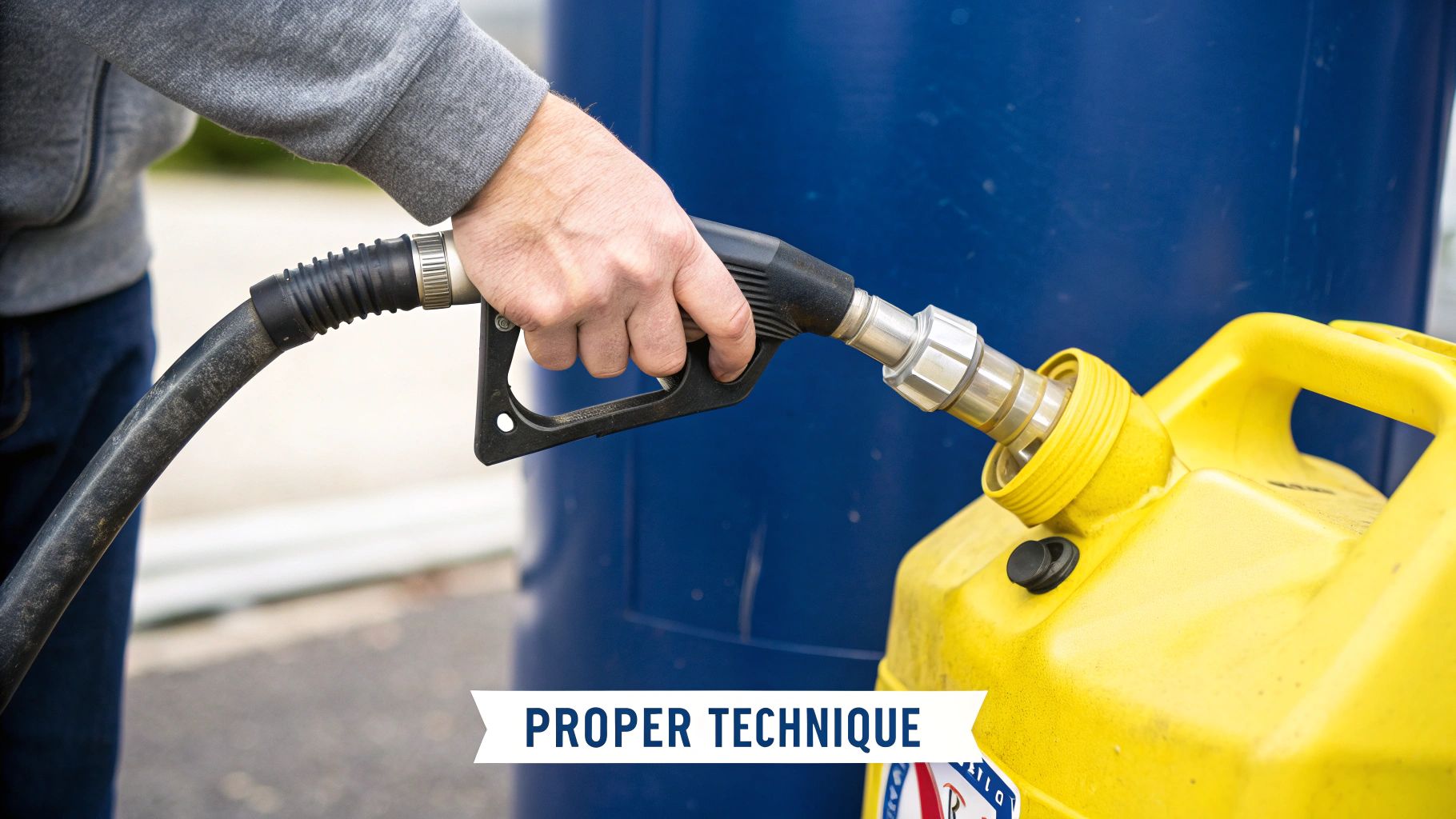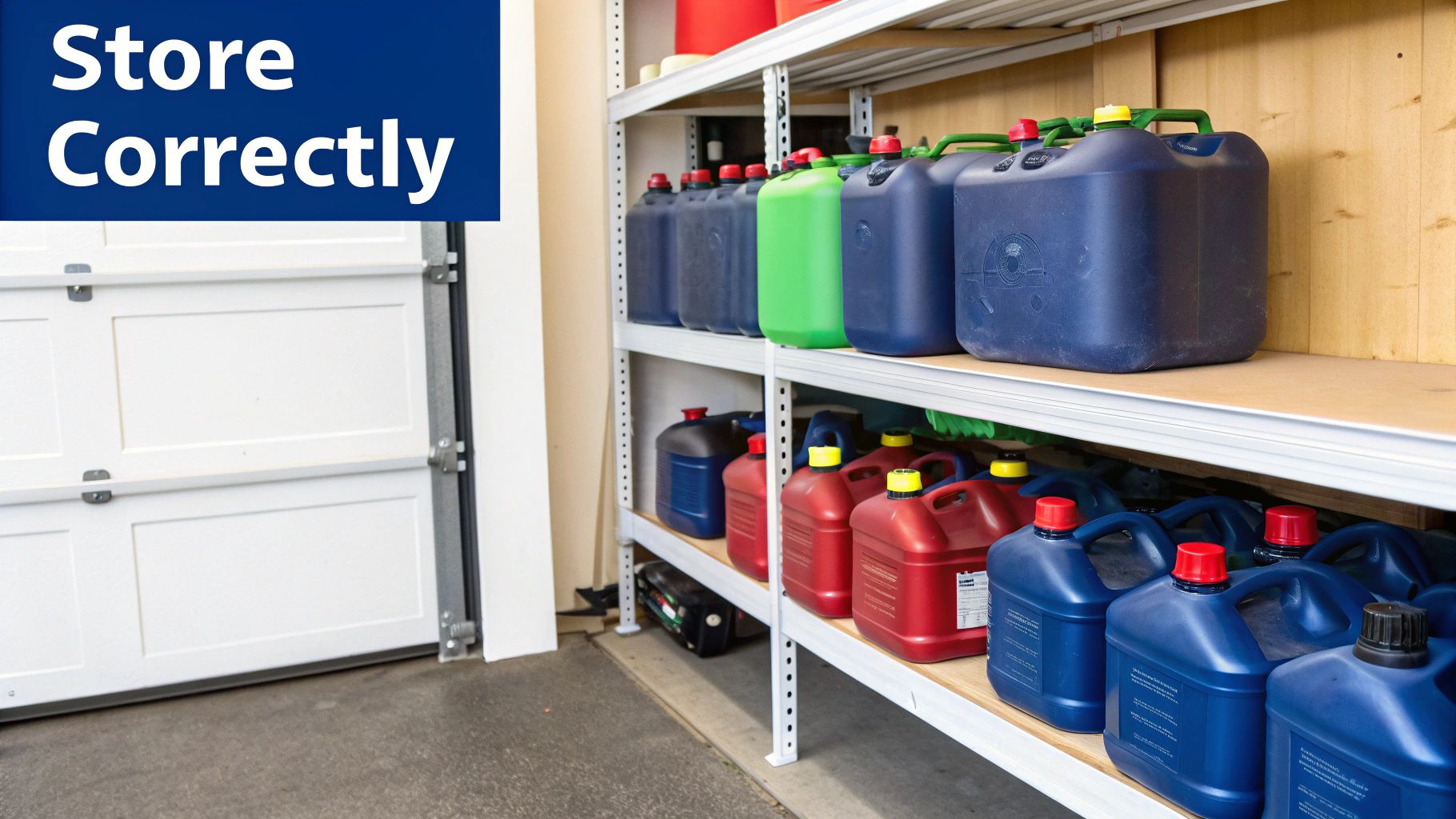Refueling your boat from a gas can doesn't have to be a risky balancing act. Using a pump gas can system is a cleaner, safer, and honestly, just a smarter way to handle fuel. Instead of tipping and pouring, you use a simple pump to move the gas, which cuts down on spills, speeds things up, and saves you from wrestling with a heavy, awkward can.
Let’s get you back on the water without the mess and hassle.
Why a Pump Gas Can Is a Must-Have for Boaters
Anyone who's tried to pour gas from a heavy can while standing on a rocking boat or a narrow dock knows that feeling. It's a surefire way to end up with a dangerous spill, a stained deck, and a big headache. That old method is inefficient, messy, and just plain stressful.
A modern pump system completely transforms that experience. You're no longer fighting gravity and a wobbly can. Instead, you have a controlled pump that transfers fuel cleanly and efficiently. It’s a simple change that makes refueling feel less like a chore and more like a quick, professional pit stop. It’s all about working smarter.
The Real-World Benefits
Switching up your refueling routine brings immediate, practical advantages. If you're tired of the old struggles, these are the reasons to make the change.
- No More Spills: The controlled flow means no more accidental overflows or messy drips onto your deck or into the water. This protects your boat’s finish and the environment.
- Less Physical Effort: Forget lifting and awkwardly holding a heavy, full gas can. This saves your back and makes the job manageable for just about anyone.
- Faster Refueling: Pumping is almost always quicker than waiting for gravity to empty the can. You’ll be back on the water enjoying your day in no time.
- Reduced Fume Exposure: A sealed system keeps gasoline fumes contained, which is a huge plus for your health and safety.
It's no surprise that safer fueling methods are becoming the new standard. The global market for fuel storage containers was valued at USD 28.6 billion and is expected to hit USD 47.3 billion by 2035. You can read more about this growing market to see how the industry is shifting. This growth really points to a massive demand for solutions that put safety and convenience first.
Traditional Pouring vs. Using a Pump
If you're still on the fence, a side-by-side comparison makes the choice pretty clear. Here’s a quick look at why a pump system is the superior option for refueling your boat.
| Aspect | Traditional Pouring | Pump Gas Can System |
|---|---|---|
| Spill Risk | High, especially in unstable conditions. | Extremely low; controlled flow prevents messes. |
| Physical Effort | Requires lifting and holding a heavy, full can. | Minimal; just hold the nozzle and pump. |
| Speed | Slow and depends entirely on gravity. | Fast and efficient, often at 4 gallons per minute. |
| Fume Exposure | High, as fumes escape from the open nozzle. | Very low due to the sealed system. |
| Convenience | Awkward and often requires a second person. | Simple, one-person operation. |
Ultimately, a pump system just makes more sense. It turns a risky, messy job into a quick and safe task, letting you focus on what really matters—enjoying your time on the boat.
Assembling Your Fuel Transfer Toolkit

Getting ready to refuel shouldn't be an afterthought. A little prep work can be the difference between a clean, safe transfer and a messy, frustrating one. This is about more than just grabbing a pump gas can and a hose; it’s about having a dedicated kit ready to go every single time.
Think of it like setting up your tools before a project. When everything is within arm's reach, you can work smoothly and confidently. This prep work drastically cuts down on the risk of spills and makes the whole job faster.
Your Essential Fueling Gear
The heart of your setup is the fuel can and pump, but a few other items will take your routine from just okay to professional-grade, ensuring safety from start to finish.
Here’s what should be in your kit:
- A Certified Fuel Can: Please don't use just any old container. A proper, sealed fuel can is designed to prevent vapor leaks and stand up to the tough marine environment.
- The CLiX Fueling Pump: This is your key piece of equipment. Before you use it, give the hoses a quick once-over for any cracks or stiffness, and make sure all the connectors are clean and lock in tight.
- Nitrile Gloves: Gasoline is nasty stuff on your skin. A good pair of nitrile gloves creates a simple barrier, keeping your hands clean and safe.
- Absorbent Pads: Even the most careful boater can have a drip or two. Keeping a few marine-grade absorbent pads handy means you can mop up any small spills immediately, before they stain the deck or get into the water.
I keep my own fueling kit—gloves, pads, and the CLiX pump nozzle—in a small, dedicated dry bag. That way, everything stays clean and organized. It’s ready to go the moment I need it, which is a lifesaver when I’m refueling somewhere other than my home dock.
Having these few things ready beforehand really does make all the difference. It turns fueling into a simple, stress-free task, so you can get back to what you're really there for—enjoying a great day on the water.
A Practical Guide to Pumping Gas From a Can
Alright, let's get that fuel into your boat’s tank. With the right technique and a good pump system, what used to be a messy chore becomes a clean, simple job. The key is to get everything set up for safety and stability before you even think about pumping.
First things first, make sure your boat is secure, whether it's tied up at the dock or safely anchored out. You don't want it rocking around. Next, find a flat, level spot for your fuel can—either on the deck or the dock—where it won't slide or tip over. Taking a moment to do this can prevent a spill before it even starts.
Making the Connection and Pumping Safely
Once you’re set, it's time to connect the pump. Firmly attach the intake hose to your fuel can and then connect the nozzle securely to your boat’s fuel inlet. You want a tight seal here. That’s what stops fumes from escaping and prevents fuel from dripping all over your boat.
Now, start pumping with smooth, steady strokes. This isn't a race. A controlled pace gives you a consistent flow of fuel and prevents the kind of splashing and air bubbles that can cause the nozzle to kick back at you.
This infographic breaks down what to look for when choosing your gear to ensure a safe transfer every time.

As you can see, everything from the fuel volume and material type to the specific safety features plays a part in a hassle-free refueling experience.
Listening for the Finish Line
As the tank fills up, pay close attention. You'll notice the sound of the fuel entering the tank changes—it usually becomes a higher-pitched gurgle. That's your signal to slow down and get ready to stop. Listening for this cue is the best way to avoid the common mistake of overfilling and making a mess.
If you're interested in the nuts and bolts of how these pumps work, feel free to check out our guide on the fuel hand transfer pump for a deeper dive.
Once the tank is full, stop pumping. Give it a second for any fuel left in the hose to settle before you disconnect. Always remove the nozzle from the boat's tank first, keeping it pointed up to prevent any last-minute drips. After that, you can detach the pump from the can.
A little pro tip: Keep an absorbent pad handy. Before you disconnect the nozzle, slip the pad underneath it. This will catch any stray drops, keeping your deck clean and protecting the water from any fuel contamination. It's a small step that makes a big difference.
The demand for better, safer fueling equipment is only growing. The global market for fuel dispensers, which includes tools like a pump gas can, was valued at USD 3.08 billion and is expected to reach USD 4.66 billion by 2033. This shows just how much people are looking for more efficient and safer ways to handle fuel.
Expert Tips for Safe and Flawless Fueling

Once you've got the hang of the basics, a few pro habits can make the process even safer and more efficient. These are the little things seasoned boaters do automatically to make sure every fill-up with a pump gas can goes off without a hitch.
Ventilation is everything. I can't stress this enough. Gasoline fumes are heavier than air, and they love to settle in low, enclosed spots like your boat's bilge or cabin. That's a serious fire hazard waiting to happen. Always, always refuel out in the open where a breeze can carry those fumes away.
Another pro tip? Fuel up on calm water if you can. A rocking boat makes for a tricky transfer, increasing the odds of a spill. Trying to wrestle a fuel can while fighting waves is a recipe for disaster.
Building a Routine of Safety Checks
Beyond just where you are, your gear and your prep make all the difference. The best thing you can do is build a consistent safety routine that becomes second nature before you even start pumping. It's about making good habits muscle memory.
Here are the non-negotiables I run through every single time:
- Fire Extinguisher at the Ready: Before you do anything else, grab your fire extinguisher. It needs to be right beside you, not buried under a pile of life jackets.
- Quick Pump Inspection: Give your CLiX pump and hoses a quick once-over. You're looking for any cracks, wear, or damage that could cause a leak. It only takes five seconds.
- Managing Multiple Cans: If you're bringing extra cans for a long day on the water, make sure they're tied down securely. Only open the one can you're actively using to keep vapors to a minimum.
The golden rule I live by is simple: anticipate, prepare, and prevent. A few moments spent on a safety check is always better than cleaning up a mess—or worse.
If you want to dive deeper, our guide on boat fueling safety provides a complete protection playbook. Think of these tips less as suggestions and more as the foundation for a safe, stress-free day on the water.
Finishing the Job: Proper Cleanup and Storage

Alright, your boat's tank is topped off, but you're not done just yet. What you do next—the cleanup and storage—is just as crucial for keeping your gear in top shape and ensuring you’re safe for the next time you head out on the water.
When you're ready to disconnect your CLiX pump, here’s a little trick I’ve learned to avoid a mess. After the pump stops, just leave the nozzle sitting in the fuel inlet for a few extra seconds. This gives that last bit of fuel in the hose a chance to drain straight into the tank instead of onto your deck.
Securing Your Gear and Handling Waste
Once you’ve disconnected everything, take a clean, dry rag or an absorbent pad and give all the components a good wipe-down. I always make sure to get the pump handle, the nozzle, and especially the threads on the pump gas can. Even a small amount of leftover fuel can attract gunk and cause the seals to break down over time, so it’s a quick step that pays off.
If you used any pads to catch spills, don’t just chuck them in the nearest trash bin.
- Know the Rules: Check with your local marina or waste management service. They have specific guidelines for getting rid of anything soaked in fuel.
- Find the Right Bin: Most marinas provide clearly marked containers for oily rags and fuel-contaminated waste. Using them is the responsible way to go.
Here's something to always keep in mind: gasoline vapors are the real hazard. A can might seem empty, but it's still full of flammable vapor. You have to treat your fuel cans and equipment with caution, whether they're full or not.
Storing your gear correctly is the final piece of the puzzle. It’s no surprise that the market for safe fueling products is booming; it’s expected to grow from USD 1.6 billion to nearly USD 2.4 billion in the U.S. by 2035. This just goes to show how much people care about handling fuel safely. You can see more about these market trends and why investing in quality equipment matters.
The ideal spot for your pump gas can and fueling gear is somewhere with plenty of ventilation, like an open garage or a separate shed. Keep it far away from potential ignition sources like a furnace or water heater. For a complete rundown, learn more about how to store gasoline safely in our other guide. And before you walk away, double-check that every cap is screwed on tight to keep vapors contained.
Got Questions About Your Pump Gas Can? We've Got Answers
Even the simplest tools can leave you scratching your head sometimes. When it comes to fueling your boat with a pump can, a few questions pop up more than others. Let's walk through them so you can feel like a pro every time you're on the dock or at the ramp.
Probably the number one question I get is about using the same pump for both gas and diesel. My advice? Don't do it. Keep one pump dedicated to gasoline and another one just for diesel. It might seem like a small thing, but preventing that cross-contamination can save you from some serious, and seriously expensive, engine headaches down the road.
What to Do When Things Go Wrong (and How to Keep Them Right)
So, what happens when your pump starts flowing slower than molasses in January? Don't panic. A sluggish flow rate is almost always a simple fix.
Before you start thinking the pump is shot, take a look at these usual suspects:
- A Kink in the Hose: This is the culprit 9 times out of 10. Make sure both the hose going into the can and the one going into your boat are straight and not pinched.
- A Clogged Filter: That little screen on the end of the intake hose is doing its job, but sometimes it does it a little too well. Debris from the bottom of your gas can get sucked up and clog it. Just pull it out and give it a quick clean.
- Dying Batteries: If you're using an electric pump, this one's a no-brainer. Weak batteries mean a weak pump. Pop in a fresh set, and you’ll likely see an immediate difference.
Here’s my go-to maintenance routine: After you're done fueling, just run the pump for a few extra seconds to clear out any leftover fuel. Wipe it down, and store it somewhere clean and dry. That little bit of effort will make it last for years.
Speaking of longevity, a quality system like the one from CLiX is designed to take a beating. But even the best gear wears out. Hoses and seals are the first things to go, especially with constant sun and fuel exposure. I make it a habit to give my entire setup a good once-over at the start of every season. Check for any cracks or brittleness in the hoses and make sure the seals are still in good shape.
Ready to make every refueling a safe, clean, and simple process? CLiX Fueling Solutions offers the reliable, spill-free system you need. Upgrade your fueling experience today at clixfueling.com.












